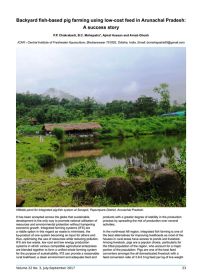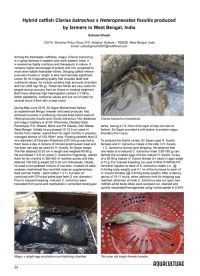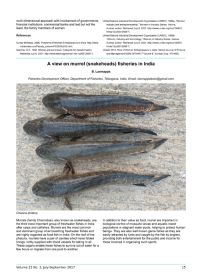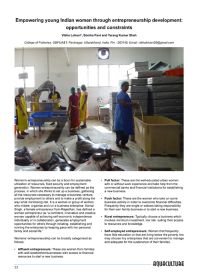In the north-east hill region of India, integrated fish farming is one of the best alternatives for improving livelihoods as most of the houses in rural areas have access to ponds and livestock. Among livestock, pigs are a popular choice, particularly for the tribal population of the region, who account for a major portion of the population. Pigs can fit into diverse systems of management, and can be reared on a wide variety of waste materials.
Hybrid catfish Clarias batrachus x Heteropneustes fossilis produced by farmers in West Bengal, India
Among the freshwater catfishes, magur (Clarias batrachus) is in great demand in eastern and north-eastern India; it is revered as highly nutritious and therapeutic in nature. During May-June 2016, Sri Sayer Mohammad Sarkar, an experienced magur breeder and seed producer, has achieved success in producing induced-bred hybrid seed of Heteropneustes fossilis and Clarias batrachus. His breeding protocol and experiences in nursery and growout of hybrid catfish are shared in this article.
Murrels (snakeheads) are the third most important group of freshwater fishes in India after carps and catfishes. Murrels are the most common and dominant group of air breathing freshwater fishes and are highly regarded as food fish. Murrels have a pair of cavities in the pharynx that have folded linings, richly supplied with blood vessels for taking in air. These organs enable these fishes to survive out of water for a few hours or migrate from one pool to another.
Women’s entrepreneurship can be a boon for sustainable utilisation of resources, food security and employment generation. Women entrepreneurship can be defined as the process, in which she thinks to set up a business, gathering all the resources necessary to manage a business venture, provide employment to others and to make a profit along the way while minimising risk while initiating, organising and running a business enterprise.
Since 2009, tilapia aquaculture has been threatened by mass die-offs in Israel and Ecuador, which have been caused by a novel Orthomyxo-like (RNA) virus named Tilapia lake virus. This has been reported as a newly emerging virus that causes syncytial hepatitis of tilapia. An emergency regional consultation was held in Guangzhou, China from 27-28 September 2017 to discuss and plan actions on the overall prevention and management of this disease.




